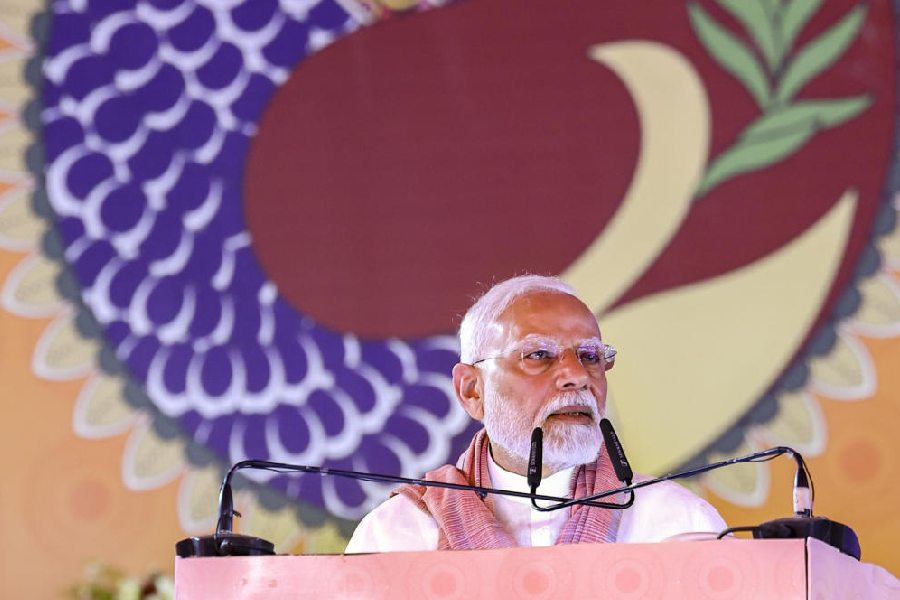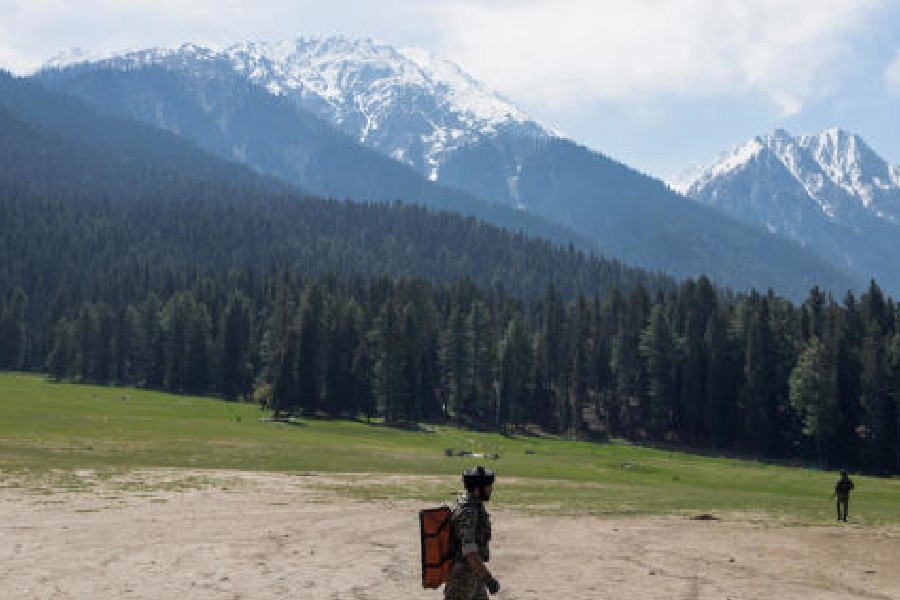
On the second floor of the Tate Modern in London, there is a timeline that stretches over a bank of windows overlooking the Turbine Hall. On this strip are marked the major artists and art movements from the late 19th century till the early 21st. All the names mentioned, whether individual artist or art movement, are from Europe and North America. There is nobody from anywhere else and certainly no Indians in that canonical graph. A few years ago, two senior curators from the Tate-Mod visited Calcutta. I asked them about this timeline and they were unapologetic: well, we do sometimes show modern and contemporary artists from elsewhere, but we are primarily a museum of modern European and American art. By inference, artists from elsewhere would be shown only in the context of their connection to, their being influenced by, their borrowing from, the canon on that wall. Or, to put it another way, no modern or contemporary art can exist on the planet without being a minor branch of this main river. For a major museum of modern and contemporary international art that the Tate Modern sets itself out to be, this is an astounding foundational assumption.
Of course, a private conversation with one individual, (no matter how high-up in the Tate hierarchy) is one thing, TaMo itself will never officially declare anything so crass, and so baldly. The museum's literature will never confess to this narrow Euro-American world view, even as the place consistently manifests it in so many of its shows and programmes. The recently opened Tate retrospective of Bhupen Khakhar's work, You Can't Please All, is an event we should celebrate, but perhaps we should exult softly, without losing sight of the problematic context in which an international viewership gets to see the pictures.
The show has received some very good reviews and there is also a long, thoughtful piece of praise and appraisal in The Guardian, by Khakhar's fellow ex-Bombayite, Amit Chaudhuri. However, this same newspaper also carried a 'review' by one of its main art critics, Jonathan Jones, who trashed the show, Khakhar as an artist and, for good measure, the supposedly dodgy philosophy ("...some misplaced notion that non-European art needs to be looked at with special critical generosity...") that invited someone like Khakhar through the doors of the temple of Western Art. Jones's glaucomic diatribe is anything but a review, and sterling proof of the fact that no one is more parochial than the person who's convinced they reside at the centre of the universe.
A major art critic may be an expert in a particular area but they are supposed to have a non-illiterate overview of international art and world art history. Even as he attacks TaMo, Jones outs himself as someone even more blinkered than the people he lambastes. Jones may not be au fait with Kalighat pat or subcontinental adivasi and folk art, but he also seems never to have laid his parsimoniously flickering eyes on a single Indian, Persian or Turkish miniature painting. Forget about art made by funny-looking people living far, far away, Jones doesn't even see the influence of Lorenzetti's Siena frescoes, he doesn't see the great riffs on Matisse, nor the deliberate, lovely debts Khakhar creates to his beloved Raoul Dufy, nothing. While the title of the show reminds me of a great Bob Dylan quip, "If I can't please everybody/ I might as well not please nobody at all," Jones's write-up brings to mind a classic Dylan song, "Ballad of a Thin Man", with its words: "You walk into the room/.../ You see somebody naked/ And you say, 'who's that man?'/.../ something is happening here/ But you don't know what it is/ Do you, Mister Jones?"
If Jones and his cantankerous bouffant weren't bad enough, we also get pearls from Laura Cumming, the critic for The Guardian's sibling organ, The Observer. Reading Cumming's review I find myself wondering if she and I have been looking at the same paintings. "Nobody could call Khakhar a natural painter or praise his figurative descriptions," states Ms Cumming, to which one could answer, "Please speak for yourself, if ever there was a natural painter it is Bhupen Khakhar." As for his "figurative descriptions", Cumming, somewhat less vitriolically, has the same problems as the hapless Mr Jones who calls Khakhar's "renditions of human flesh" "drab and vague". Again, the stink of a certain inbred world view rises from both these reviews. No one is more precise and less drab in his depictions of the middle-aged and older Indian male than Bhupen Khakhar; I'd stick my neck out further and say that Khakhar's engagement with the non-idealized, naked body undergoing inevitable entropy is as deep as a Lucian Freud's; if you must compare, it's also as particular - just as you don't see too many people of colour in Freud's pink-fleshed universe, Khakhar's world - as far as naked bodies go - consists primarily of the older, small-town Gujarati male. The problems for the aging village-yokels writing in The Guardian/Observer are firstly, that they are not familiar with this kind of human body, and secondly, they clearly can't decipher the layering Khakhar puts upon those bodies, distortions which come not from Western art but the tropes and vernaculars of the subcontinent's own rich visual traditions. Cumming and Jones make one imagine a pair of provincial, conservative French gourmands (from long ago) who suddenly find upon their tongues the shocking tastes of chilli, tamarind, karela and hing.
How does one explain (and should one even bother?) to people who blithely claim that Khakhar had "no fluency or touch with the brush" that this man was actually contemporary Indian art's equivalent of Frank Zappa? That the incredible virtuoso guitar, the cutting-edge avant-garde arrangements, were all placed behind a high screen of ribald humour and irreverence, and just as you have to work to hear this stuff in Zappa, so you have to look out for how beautifully a bedsheet or an elephant is painted in Bhupen's work, or how a profile or a range of monsoon clouds are put down with such effortless poetry?
The other thing that Cumming complains about is the absence of context and explanation in the exhibition. One can connect this to a point made by a friend that, having paid £12 to enter the show, one should not then be expected to also fork out for an audio-guide and/or a catalogue in order to receive the fullest explanation of what one is looking at. Not having seen the exhibition, I don't know how much water this complaint holds. Thinking about it in terms of a public museum, without context how would you decipher, say certain periods of Sigmar Polke's work, or all of Jean-Michel Basquiat? Are they daubists, primitifs, naifs, talentless pranksters? Are they exuberant but empty quoters, one of porn and the other of some Africanish slash and burn of colour? Without context how do you 'read' someone like Cy Twombly or, to take a different extreme, Alighiero Boetti? Is one a wall-scrawler who can't even form simple words properly, is the other an overgrown schoolboy messing with scrapbooks of world geography? What happens to poor Joseph Beuys then, with his obscure Teuton- tantric rituals with fat, felt, gilt and wolves? Someone could just Jones into a gallery, look at the work of any of these people, work un-escorted by any bodyguards of context, and ask, "What's this joker about, anyway?"
The fact is, there is a distinction between the relevance of an artist in specific social and cultural contexts and the way the actual work jumps across cultural gaps and elicits experience, about how it moves you or doesn't. In an ideal show, both the visceral effect and the curatorial contextualizing should combine to make a sum greater than the two parts. Perhaps this does happen in the Tate show and perhaps we - especially those of us who haven't yet seen the show - shouldn't let two clearly ignorant critics colour our perception of the show's success. Perhaps we should avoid getting overexcited, either by the 'acceptance' or 'recognition' of one of our most important artists by one of the heavily fortified art cathedrals of the West or by the fact that some critics, albeit in the Indian Left-liberals' two favourite newspapers, just don't get Khakhar.
I knew Khakhar - Bhupen bhai to me - somewhat, nowhere as well as his close friends knew him, and today I miss him terribly. As I read about the show at the Tate, I imagine standing with him at the riverside watching people go by. I suspect he might have been a tad upset at the stupid reviews, but not for long. I can imagine him standing there with a completely straight face, looking innocent and harmless, muttering wicked Gujarati profanity-combinations in a low voice.
I like to think he would have dismissed Jones and Cumming with some well-deserved expletives. I like to think he would have then turned upon our 'own kind'. I cannot but imagine that had he been alive, he would have made brilliant, nastily accurate portrayals of the fat, middle-aged, small-town Gujarati man who is selling himself to the world right now as the Face of India. At the riverside, Bhupen would have had some stomach-splittingly funny things to say about the Face of India's recent speech to the US Congress. As we walked down to a pub for a drink, Bhupen would not have spared the cultural environment in India and the hypocrisy over retaining Article 377. He would have noted that at least the Tate Modern could have a huge show of his paintings today, a show backed largely by Indian collectors and private museums. He may or may not have pointed out that in today's India, such a show, by the most important painter and cultural figure Gujarat has produced in the last 70 years, would be impossible to mount.










